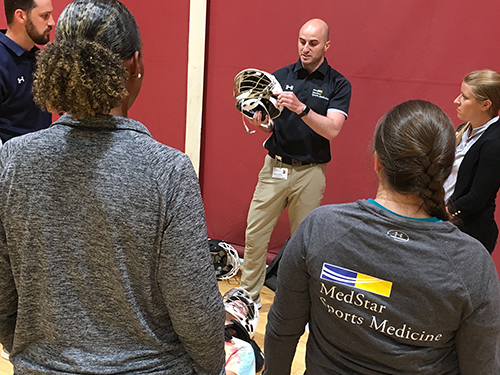Athletic Trainers Practice Too, When it Comes to Saving the Lives of Student Athletes
Did you know a tarp, a bucket of ice water and the right training is all you need to start treating a student athlete suffering from heat stroke? MedStar Health athletic trainers, sports medicine physicians and local EMS partners hit the gym at Howard Community College; putting their skills to the test creating ice baths (and much more) to practice live-saving techniques before real medical emergencies happen on the field.

During the annual, full-day class presented by MedStar Health, participants learned from healthcare leaders on topics such as clearing an athlete for play after heat illness, care of traumatic fractures and dislocations, responding to a mental health crisis, managing heart conditions seen in young athletes and recognizing other red flags.
“We do this every year because the best practices for emergency response are updated often and we need to empower our athletic trainers to be experts on the latest developments,” said Kimberly Bosley, director of Athletic Training Services at MedStar Health. “In a real emergency, this knowledge and experience can make all the difference.”
In the afternoon, athletic trainers split into six group focusing on the real-world application of those skills. Real volunteer student athletes from Howard Community College suited up in football pads, helmets, straps, stretchers and more to get athletic trainers as close as possible to handling a real emergency.
“Through practice, we can minimize delays in care and provide the best quality care immediately on the sidelines, in the gym in the pool deck or where ever those athletes may have their injury,” said Emergency and Sports Medicine physician Kori Hudson, MD.
The drills included building an ice bath for heat illness, spine boarding, setting up an automated external defibrillator, CPR compression timing, and proper equipment removal for an injured athlete.
 “Athletic trainers really are the best qualified to do this because they know the athletes and they know the equipment better than hospital staff do,” Hudson says of properly stabilizing a neck injury. “We want to practice doing that here so that they can work with their EMS colleagues and the ER staff to safely remove equipment in an emergency.”
“Athletic trainers really are the best qualified to do this because they know the athletes and they know the equipment better than hospital staff do,” Hudson says of properly stabilizing a neck injury. “We want to practice doing that here so that they can work with their EMS colleagues and the ER staff to safely remove equipment in an emergency.”
“Whether it’s something as simple as CPR and compressions, it’s a lot easier to practice it today when there’s no stress, so you’ll do a better job in the real-time of the moment you need it,” says Sports Medicine specialist Matthew Sedgley, MD.
If you are a coach or athletic director and need help preparing an emergency action plan, contact us at MedStarATC@medstar.net.









